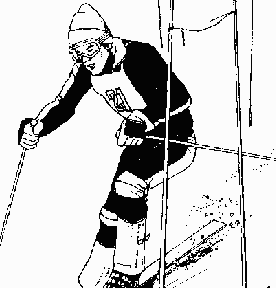

As I stated earlier Earl Miller loved ski racing and soon had meets scheduled at several ski areas south of Salt Lake City. Alta and Brighton already had their own race events which generally included the top racers for the Intermountain area.
Provo outdoor people had the Timp Mountain Club which I joined soon after arriving at the University. Like the Wasatch Club in Salt Lake City it scheduled outings and events throughout the year. Many of the people I skied with were president of the Club at one time or another including Junior Bounous, Frank Hirst and Reed Biddulph. But generally speaking ski racing was not the major focus for the Club and its members. Early on we did all race under the banner of the Timp Mountain Club which was accredited by the Intermountain Ski Association. I recall one race at Brighton where we competed against the Wasatch Mountain Club. At that time we were all Class C racers and the field from Provo in that meet included Junior Bounous, Phl Snelgrove, Frank Hurst, Jim Gessford, Rex and John Spendlove and this writer. The women competing were Irma Stirman who was a Class B racer and Lorraine Linde in Class C.
To further ski racing in the area it was decided to form a new organization which would focus on ski racing and sending members to ski meets, jumping or alpine, whenever possible. So the Edelweiss Ski Club was established. Most of us continued our membership in the Timp Mountain Club as well. And the Park City jumpers continued their membership in their Club as well.
I recall the first race in which we competed under out new banner. It took place at Clear Creek in Carbon County which was a mining town near Price, Utah. For that race almost the whole town turned out to watch what was a very open giant slalom. We hiked a good distance above where the tow ended sidestepping the proposed course in new snow. Six of us from Provo competed included Phil Snelgrove, Earl Miller, Junior Bounous, Frank Hirst, DeMont Johnson and this writer. The women were represented by Peggy Miller, Jeanne Randall, Maxine Lamborn and Shirley Lamoreaux. The thing I remember most about that day was that I finished and had my best outing to date. And it was in my first year of skiing.
We also had a race that season at Bluebell in Manti that year. I have already told how this area had been developed in Ephraim Canyon by a local group. All the skiers who had participated in the Clear Creek meet also raced at Bluebell in Sanpete County. The Bluebell area had the Sanpete Ski Club and included some very good racers in its ranks. Gene Smith, Boyd Henrie and Gordon Despain were among the best. Later Gordon Despain enrolled at BYU and became a member and competed for the Edelweiss Club. All these Utah men had been skiing for many years and had a long head start on me. I never won any races during my school years in Provo but did place a few times. But I enjoyed the challenge and most of the racers were great people and fun to be with. Also I ended up as chronicler for most of these events since I was majoring in Journalism. In conjunction with some of these classes I was an apprentice at the Daily Provo Herald. I wrote general assignment stories but the sports editor was only too happy to let me cover skiing for the paper. And I served the same function for the College paper as well.
Phil Snelgrove had beautiful skiing skills and form but he sometimes lacked the desire to win. DeMont Johnson was just the opposite. He didn't look good on the hill but he was fast and went all out in every race. DeMont developed into the best ski racer south of Salt Lake City for a few seasons. Sadly a few years later he was killed in a motorcycle accident. Another plus with these local races was the wonderful hospitality we received from everyone. It was a fine way to meet interesting people and make new friends.
One year I worked for Earl Miller at his ski shop putting bindings on skis or repairing metal edges which needed a lot of care as the screws would sometimes pull out of the wood. I was not his regular ski tech but only filled in if the person who generally did the work was not available. However one summer I did make ski waxes for Earl under his own Miller label. The previous winter Earl had spent a good deal of time experimenting with various waxing formulas. We would wax several pair of skis with different combinations, take them to Timp Haven, and see what would be fastest and work best. It was rather a hit and miss effort but Earl finally decided on three different wax formulas: one for cold snow conditions, one for temperatures around freezing point; and a third for Spring snow conditions.
I was going to Summer School at the "Y" and had some extra time so Earl asked if I wanted to make the waxes. I was the only one besides Earl who knew the exact formulas for each wax. Earl had some packaging designed and made for each of the three waxes which were simply labeled Number one, two or three: one for the coldest and three for the Spring mix. I made all the product for Miller's waxes that summer behind his ski shop. The formulas were Earl's and I have never told anyone what they were.
In a short time even wooden skis were manufactured with plastic bottoms and waxing became less important. But ask any racer and to this day waxing for special snow conditions is considered crucial for success.
Graphic Design by Impact Graphics